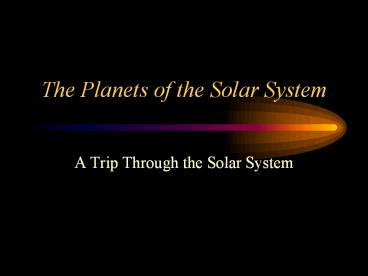The Planets of the Solar System - PowerPoint PPT Presentation
1 / 29
Title:
The Planets of the Solar System
Description:
The Planets of the Solar System A Trip Through the Solar System Mercury - named after the speedy messenger of the Roman gods Closest planet to the sun Revolution ... – PowerPoint PPT presentation
Number of Views:193
Avg rating:3.0/5.0
Title: The Planets of the Solar System
1
The Planets of the Solar System
- A Trip Through the Solar System
2
Mercury - named after the speedy messenger of the
Roman gods
- Closest planet to the sun
- Revolution around the sun 88 Earth days
- Rotation on its axis 59 Earth days
- Crater-covered surface with steep cliffs
- Almost no atmosphere
- Temperature range
- as high as 427 degrees C
- as low as -170 degrees C
3
Mercury - named after the speedy messenger of the
Roman gods
http//pds.jpl.nasa.gov/planets/welcome/mercury.ht
m
4
Venus - named after the Roman goddess of beauty
and love
- Second planet from the sun
- About the same size as Earth
- Thick, cloudy atmosphere
- sulfuric acid
- carbon dioxide
- Temperature range
- as high as 480 degrees C
5
Venus - named after the Roman goddess of beauty
and love
- Surface pressure 91 times more than Earths
- Surface has
- deep canyons and tall mountains
- craters
- vast plains
- Revolution around the sun 224 Earth days
- Rotation on its axis 243 Earth days
6
Venus - named after the Roman goddess of beauty
and love
- Greenhouse effect
- heat becomes trapped beneath the clouds
- results in little or no water on Venus surface
7
Venus - named after the Roman goddess of beauty
and love
http//pds.jpl.nasa.gov/planets/welcome/venus.htm
8
Earth
- Third planet from the sun
- Revolution around the sun 365 days
- Rotation on its axis 24 hours
- Because the axis of the Earth is tilted, this
creates distinct seasons throughout the year
9
Earth
- Temperature range depends on the location,
altitude and season - Gravitation pull of the moon creates tide changes
(rise and fall of the ocean levels) - Surface -
- Mountains
- Plains
- Deserts
- Heavy vegetation
10
Earth
http//pds.jpl.nasa.gov/planets/welcome/earth.htm
11
Mars - named after the Roman god of war
- Fourth planet from the sun
- Surface
- rocky
- large craters
- soils is similar to Earths soil in many ways
- four large volcanoes (dormant)
12
Mars - named after the Roman god of war
- northern ice cap
- frozen water
- southern ice cap
- frozen carbon dioxide
- Very thin atmosphere
- High winds often create dust storms
- Temperate falls well below 0 degrees C all the
time
13
Mars - named after the Roman god of war
http//pds.jpl.nasa.gov/planets/welcome/mars.htm
14
Jupiter - named after the king of the Roman gods
- Fifth planet from the sun
- Largest planet
- Made of mainly
- hydrogen
- helium
- Temperature range -
- very cold at the cloud tops
- as high as 30,000 degree C at the core
15
Jupiter - named after the king of the Roman gods
- Atmosphere
- hydrogen
- helium
- ammonia
- methane
- Great Red Spot
- hurricane-like storm (as much as 20,000 years old)
16
Jupiter - named after the king of the Roman gods
- Very high atmospheric pressure
- Giant magnetic field
- created by the liquid metallic layer
- called magnetosphere
17
Jupiter - named after the king of the Roman gods
http//pds.jpl.nasa.gov/planets/welcome/mars.htm
18
Saturn - named after the Roman god
- Sixth planet from the sun
- Surrounded by rings
- made of icy particles
- has at least seven major rings
- Made of mainly
- hydrogen
- helium
19
Saturn - named after the Roman god
- Violent atmospheric storms
- Very cold
- Has a large magnetic field
- Lowest density of all the planets
20
Saturn - named after the Roman god
http//pds.jpl.nasa.gov/planets/welcome/saturn.htm
21
Uranus - named after the father of Saturn in
Roman mythology
- Seventh planet from the sun
- Atmosphere
- hydrogen
- helium
- methane
- Temperature range
- as low as -220 degree C at the cloud tops
22
Uranus - named after the father of Saturn in
Roman mythology
- Extreme atmospheric pressure
- atmosphere is 11,000 kilometers thick
- Rotates on its axis at a 90 degree angle
- appears laying on its side
- Rings of methane ice surround it
23
Uranus - named after the father of Saturn in
Roman mythology
http//pds.jpl.nasa.gov/planets/welcome/uranus.htm
24
Neptune - named after the Roman god of the sea
- Eighth planet from the sun
- Atmosphere
- hydrogen
- helium
- methane
- Temperature
- as low as -220 degrees C
25
Neptune - named after the Roman god of the sea
- Surface
- ocean of water and liquid methane
- rocky core
- Five rings surround Neptune
- made of dust particles formed from meteorites
26
Neptune - named after the Roman god of the sea
http//pds.jpl.nasa.gov/planets/welcome/neptune.ht
m
27
Pluto - named after the Roman god of the
underworld
- Ninth planet from the sun
- Smallest planet
- Least dense planet
- Seems to be made primarily of methane ice
- Thin atmosphere (only on the sunny side)
- methane ice evaporated to form this
28
Pluto - named after the Roman god of the
underworld
http//pds.jpl.nasa.gov/planets/welcome/pluto.htm
29
Other Websites
Planet Scapes
Views of the Solar System
Interactive Planet Tour
Planetary Paths
Orbital Motions - The Inner Planets

